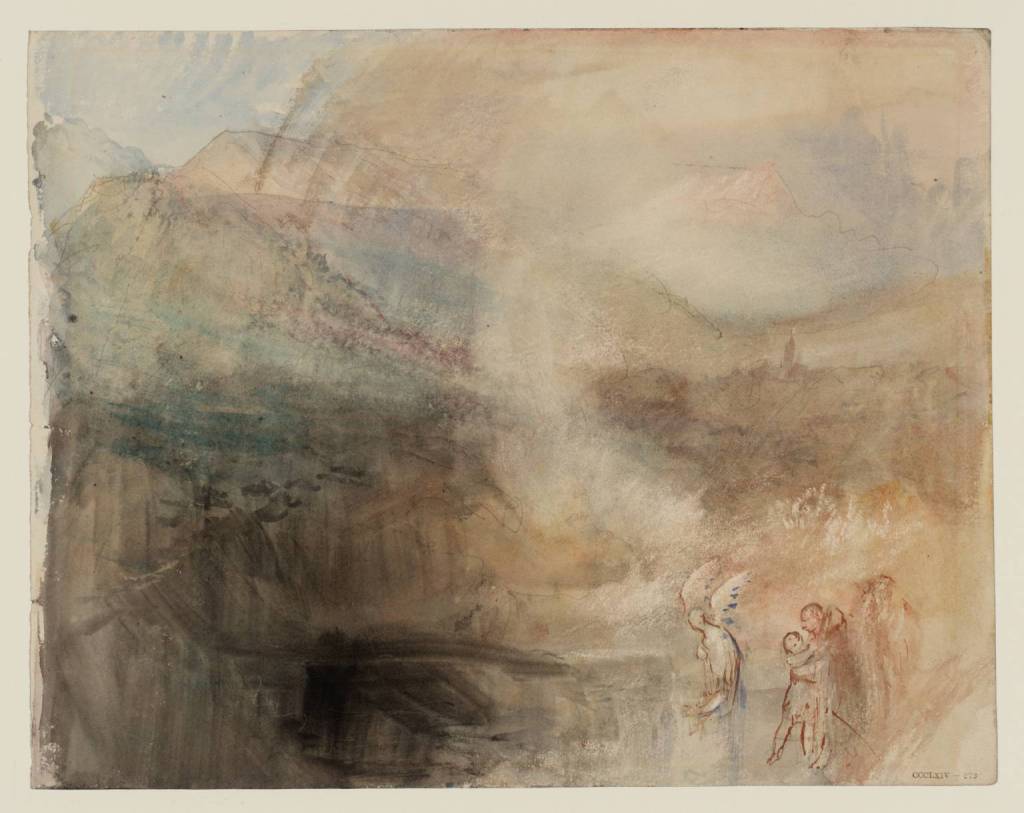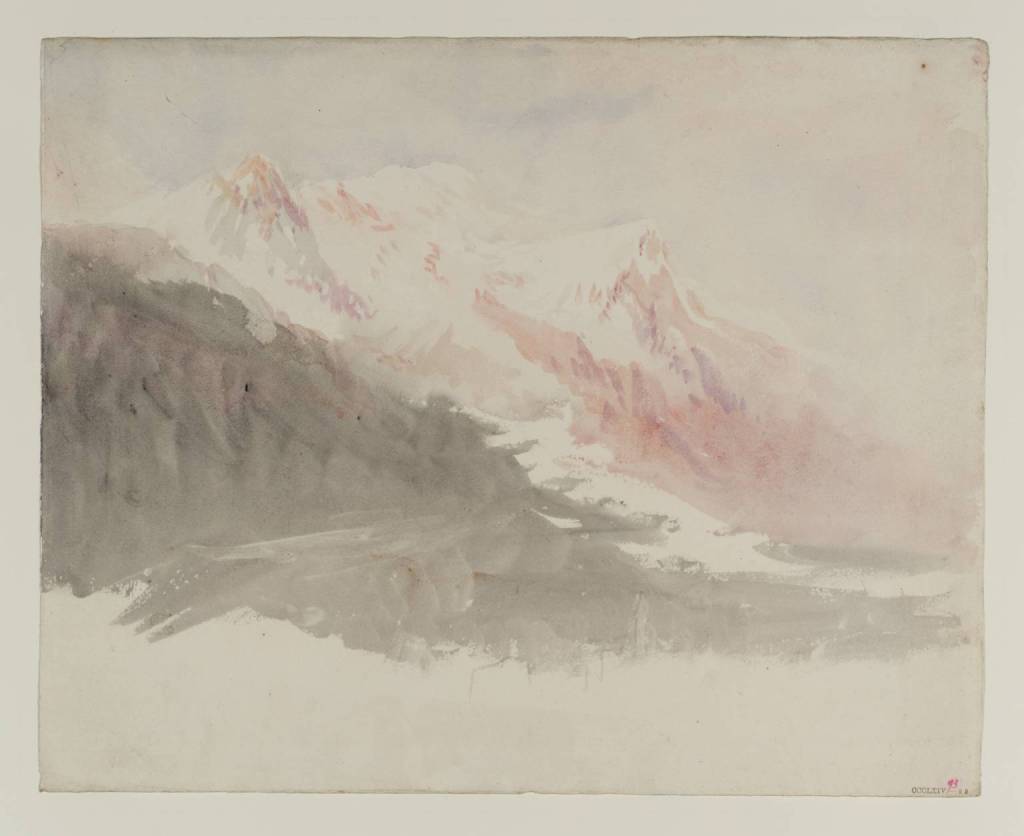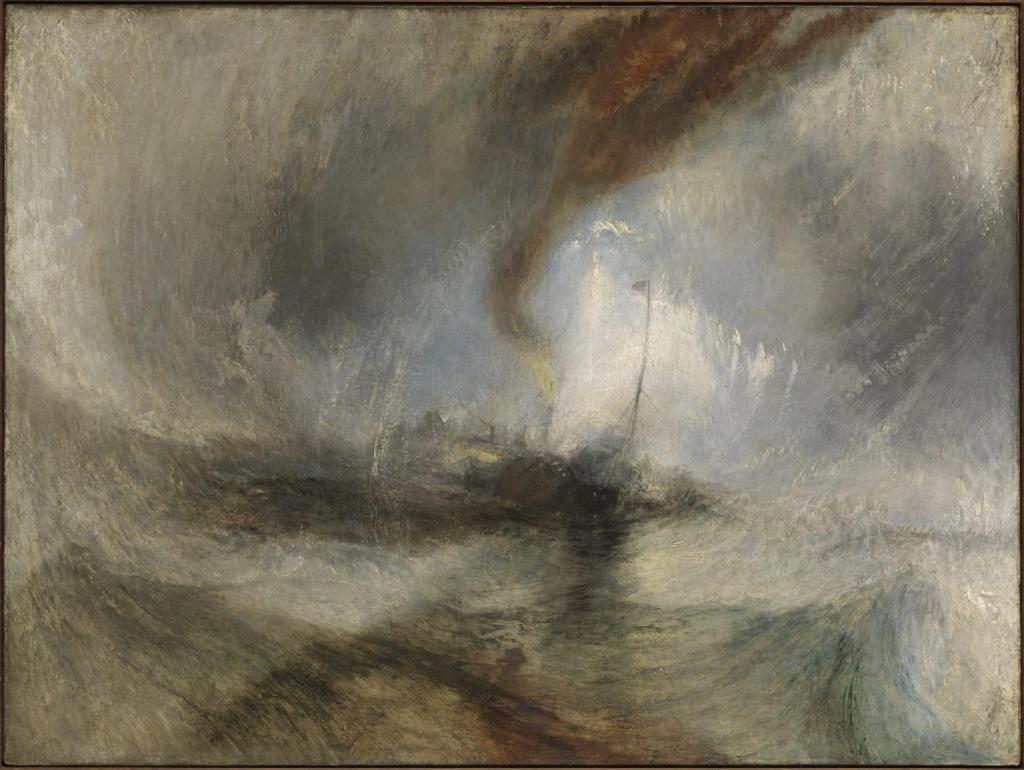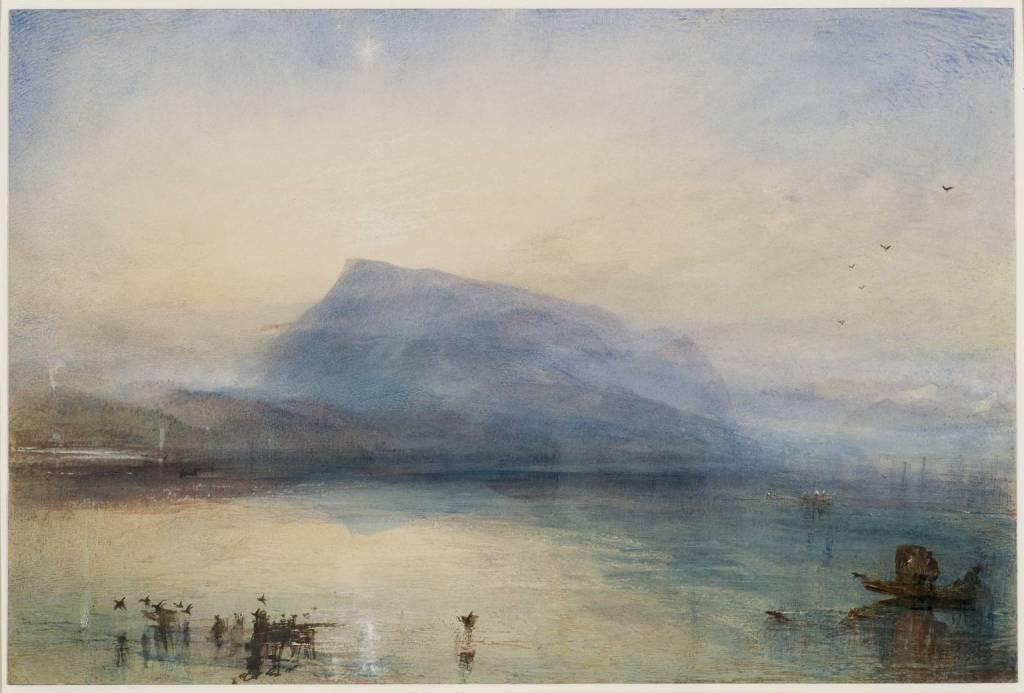Late Turner: Painting Set Free
Tate Britain, London
10 September 2014 – 25 January 2015
Turner was a child prodigy and an undeniable genius, although apparently he knew little about anything other than art. The title of this exhibition, ‘Painting Set Free’, describes exactly what Turner’s career did for the art of his time; he provided a desperately needed revolution for art of 1800s, a spirit of freedom which endures to this day. He died in 1851, working up until his death while suffering terribly with cataracts, diabetes and heart disease (for which copious amounts of sherry was prescribed). It was during his last decade or so that he made some of his most original and visually striking art, creating numerous studies, working and reworking paintings over the years.
The Angel Troubling the Pool (c.1845) was the first artwork to catch my eye. It is an almost abstract landscape in watercolours, with sloping mountains in the background and small pencilled figures in the foreground. The title comes from a bible story when an angel troubles a pool of water, into which the sick submerge themselves and emerge healed. Considering the significance of the subject Turner has chosen to make the landscape almost swallow the activity. They are almost sketched in as an afterthought. He has also moved the scene from Jerusalem to the Alps, perhaps inspired by his time there and envisioning it as idyllic setting worthy of a biblical miracle. But what is most striking is the vortex of paint that swirls around the surface. It creates an arc of light in the top right corner, illuminating the scene and framing the horizon, and steeps the bottom left in darkness. It calls to mind Turner’s famous quote ‘If I could find anything blacker than black I’d use it’. To me it seems that the black is all the disease drawn out of the people, a visual for the evil that ailed them. The angel stands looking pensively at the dark mess as if willing it to disappear. It is painted energetically, angrily even, maybe hinting at a reflective on his own frustrating state of illness.

The Angel Troubling the Pool (c.1845) by J.M.W. Turner, graphite and watercolour on paper, Tate, London
We can see from his sketchbooks that Turner was an obsessive painter, fascinated by the effects of sunlight and weather, and determined to capture the different variables. From 1835-1845 he travelled Europe extensively, visiting France, Switzerland, Denmark, Germany and Italy. Clearly enamoured by Mont Blanc and the surrounding Alps, as he sketched them at nearly every time of day and during all weather conditions. Mountains in particular show spectacular atmospheric effects, and Turner’s sketches are experiments with colour and media to express these ever-changing views. Mont Blanc and the Glacier des Bossons from above Chamonix, dawn (1836) is one such sketch, which shows in minimal detail the pink-tinged sunset upon the snow of the mountain. Delicate daubs of a brush loaded with transparent watercolour have been built up to depict the mighty Mont Blanc. It feels so fresh and modern. The clarity of light and air contrast with the imposing rocky creations of nature, rooted in the earth and looming over us. Turner is a romantic, and sees nature through a poetic and contemplative perspective, a point of view which many painters of the time were adopting.

Joseph Mallord William Turner Mont Blanc and the Glacier des Bossons from above Chamonix, dawn (1836) J.M.W. Turner
I was particularly interested to see Turner’s sketchbooks, as they give an insight into the thoughts and processes of the artist, showing us how he worked to develop his large canvases. It was nice to see his sketches from the Dresden Picture Gallery, where he copied old master paintings in the same way that visitors to this exhibition were frantically copying his. It shows Turner’s appreciation for the past, specifically Claude Lorrain who was Turner’s idol. Although his own artworks break with tradition they feel as though they have inherited something from his predecessors, they follow a linear evolution. Turner was of course a Royal Academician, his education and fellow RAs would have applied their knowledge of art history in the same way. Historically the grand themes of history, myth and religion were seen as superior subjects for art. But of course Turner was mainly preoccupied with landscape and natural world, and he elevated this humble subject matter to a level not before seen in England.
One painting that I was familiar with and keen to see again in the flesh was Snow Storm – Steam-Boat off a Harbour’s Mouth(1842). Turner was fascinated by extreme weather, so much so that legend has it he was tied to the mast of a ship to witness the violent clashing of elements with the sea. A highly unlikely story but one that is telling of the artist’s relentless obsession. I love this picture, despite having an extreme fear of the sea and especially the sort of storms that throw ships around as is happening here. Again there is a feeling of nature as a dangerous and terrible power. In fact two years before this painting was made a ship called The Fairy sank during a storm at sea leaving no survivors. The colours are muted dirty greys; the white of the ship’s masts being visible at the centre of the storm. Again the composition is dominated by a swirling cyclone. You can imagine the cold, whipping winds and spray of the tumultuous waves. It really is an awesome vision, quite radically abstract and experimental in style.
Amongst the Swiss Alps and partially surrounded by water is Mount Rigi, known as the Queen of Mountains. It clearly captured Turner’s imagination as he sketched the mountain numerous times. He travelled around Europe regularly between 1841-44, passing through Switzerland. The atmospheric effects of light and weather on mountains clearly fascinated Turner, and other tourists who would venture to the area to witness the sunrise and sunset. The Blue Rigi, Sunrise (1842) particularly stood out for me, the looming sculpted mountain set against the picturesque landscape, the beautifully captured light of sunrise, a transitory thing that changes by the minute. The veils of yellows and blues give a feeling of tranquility, a mood of contemplation and peacefulness. I wonder if Turner felt this way too. It is cool, bright and calm, with the exception of the birds disturbed by a dog in the bottom left. Turner has used delicate washes of paint, hatching and dabbing to create texture. I loved the fact that to create the one single star in the sky that Turner used a fingernail to scrape away to the white paper below, an idea of using a finger as a tool which is later adopted by modern artists to integrate themselves with their works. In a way Turner is painting as a meteorologist, his painting is dictated by it and is a vehicle with which to depict it.
The word ‘late’ in the title of this exhibition refers both to Turner’s final years in life, but neatly describes a last artistic flourish in Turner’s work. The landscape was Turner’s life-long muse. It inspired his art, allowed him to develop technique and provoked a need to invent a visual language. Many of his works have grand titles of history or myth, but nature is always the real focus. Landscape as seen as an inferior subject matter, not one for artists to concern themselves with. But Turner elevated it in the same way that his hero Claude Lorrain did, showing it worthy of equal recognition. By looking at Turner’s plethora of sketches and experiments in this exhibition you get a feel for his love of landscape, an admiration and fascination with the world around him. He once very frankly said ‘I don’t paint so that people will understand me, I paint to show what a particular scene looks like’. But what we see is seen through his eyes, and no one painted like him. The show includes Turner’s death mask, his old and withered face (he lived to reach 76) has an expression of peace and contentment. I left the exhibition with this feeling too.


